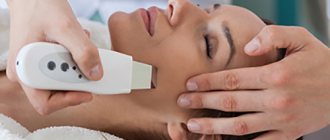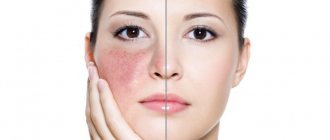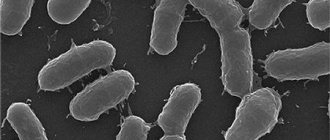Skin types
Structurally, different people's skin looks the same. The main difference is the intensity of the sebaceous glands. Let's look at each of the four main skin types in detail.
Normal skin
Main characteristics:
- smoothness and dullness of the cover;
- pores are narrowed;
- wrinkles appear after 35 years;
- the influence of the menstrual cycle on the condition of the skin is absent or minimal;
- no irritation, peeling, acne;
- pinkish tint.
The most problem-free type, which can be found extremely rarely - only 6% of the world's population can boast of this. Most often these are children under eleven years of age. Such people are not bothered by acne during adolescence. Age-related changes are slow.
Oily skin
Key Features:
- clogged, wide pores;
- oily, shiny surface (even after washing);
- there are comedones, inflammation, black spots on the nose (sometimes also on the forehead, chin);
- makeup fades a couple of hours after application;
- grayish color.
The good news for people with this skin type is that it fades more slowly, thanks to the increased activity of the sebaceous glands. After thirty, as a rule, the skin type becomes mixed.
Dry skin
Main differences:
- the cover is thin;
- pallor, dullness;
- there is peeling, a feeling of tightness;
- frequent allergies to cosmetics;
- makeup stays on well;
- In the morning, the skin is often irritated.
Age-related changes are noticeable after 25 years. The skin loses turgor, becomes less elastic, small wrinkles form around the eyes and mouth, as well as on the forehead. Any temperature changes affect the appearance of the skin - heat or cold can cause redness.
Combination skin
It is distinguished by:
- the face has dark shades;
- The T-zone is often shiny;
- enlarged pores in certain areas;
- in the area of the neck, cheeks, and temples the dermis is thinner;
- before the onset of menstruation, rashes are possible;
- uneven complexion.
Aging is unpredictable.
Causes
Itching, redness, cracking of the surface, extremely uncomfortable sensations - any of us are familiar with this condition of the epidermis.
For some, a noticeable deterioration is associated with hormonal levels, for others - with cold weather (they often talk about an allergy to cold, although in its pure form it is rare). Only a thorough and comprehensive diagnosis will help answer the reason for the deterioration of the condition. Many patients come with the question: if the skin of the body is very dry, then what should be done? What means to choose to get rid of the problem? However, the doctor will first of all find out why it occurred.
There can be many “triggers”. Let's list some of them:
- Exposure to external factors, including sunlight, air conditioning, temperature changes, and so on.
- Age-related changes (senile xerosis).
- Lack of vitamins, including A, E and C. They are often called the “secret of youth,” although there is no secret in their action. These important components fight antioxidants, maintain the balance of the epidermis and its tone.
- The innate physiological characteristics of the body often answer the question of why the skin becomes dry. This is a so-called constitutional disorder, which is often observed in childhood, when parents of children aged 2 years and older pay attention to poor epidermis.
- Xeroderma is a pathological situation; defects are mainly visible on the face and flexor surfaces. In this condition, the permeability of the epidermal barrier is impaired.
- Allergic reactions.
- Various diseases, including fungal ones.
- Dermatoses also become a factor in the patient developing dryness, and the causes are called differently: contact and allergic, ichthyosis, psoriasis, but all of this is one class of pathologies.
Skin type test
A professional cosmetologist in a clinical setting can easily determine what type of skin you have using a device called a dermatoscope. You can try to determine your type yourself. There are several ways to do this.
Method 1
Clean your face and do not apply makeup. After two hours, notice how your skin has changed:
- Normal. The shade does not change, there is no feeling of tightness or greasy shine.
- Dry. Tightness or flaking, which can be eliminated with a rich cream.
- Combined. The T-zone and cheeks are shiny.
- Fat. It acquires shine over the entire surface.
Method 2
As in the first case, you need to wash your face and wait 2 hours without applying any makeup. Next, a thin napkin is pressed tightly to the face. Your type is determined by traces of sebum:
- Fat. Imprint of sebum on all areas.
- Dry. There are no stains left on the paper. Skin particles may remain.
- Mixed. Marks in the T-zone, sometimes also on the forehead and/or chin.
- Normal. Minimal traces.
Both of these methods are as unreliable as they are simple. It is important to understand that you can make a mistake and harm yourself with the wrong care.
Other leather characteristics
In addition to this division into types, there are other categories of types of epidermis. Cosmetologists highlight the skin:
Problematic. This type most often occurs during puberty, from fourteen to twenty-five years. Characterized by various inflammations, acne, etc.
Mature. It is characterized by noticeable age-related changes, the presence of wrinkles around the eyes and on the forehead, the appearance of nasolabial folds, and drooping of the facial contours (also called ptosis).
Sensitive. Allergic skin, prone to irritation, itching, burning.
Cooperose. It is distinguished by visible capillaries located close to the surface.
Prevention
There are ways to reduce the impact of environmental factors and prevent problems:
- Wear rubber gloves when constantly in contact with water and detergents.
- Avoid using household chemicals unless necessary.
- Do not overuse your face with tap water: its composition often causes peeling.
- When looking for a way to get rid of dry skin, analyze which substances may serve as allergens for you.
- Protect yourself from the effects of negative environmental factors.
- Do not overuse cosmetic procedures associated with trauma, do only gentle peelings and do not use abrasives with coarse particles. Even those that are designated as soft in the instructions can seriously scratch.
- Use care products selected individually, taking into account all the nuances of the current condition.
Proper nutrition
When choosing options for how to get rid of dry skin, pay attention to your diet. It is recommended to enrich it with vegetable oils, in particular those based on flax. It contains omega-3 fatty acids, in greater quantities than other vegetable fats, and has a beneficial effect on health. Flaxseed oil also contains many components that prevent external aging.
If we talk about other sources of omega-3 acids, then this is fish, which is also recommended to be included in the menu.
Avocado is rich in healthy fats and helps retain moisture. So, if the question arises, what to do when your skin is very dry, enrich your menu with this useful product.
The condition of the epidermis is also favorably influenced by the nutrients contained in eggs. The protein contains essential amino acids, and the yolk contains vitamins and folic acid, which, by the way, is also found in greens and green vegetables.
Care products
When patients complain of flaking and dryness, there may be different reasons. However, today there are products that are recommended in most cases to get rid of peeling and cracking.
Most often, doctors prescribe drugs with hyaluronic acid. Normally, it is found in the body and has the ability to retain water molecules. Thus, hydration of the outer integument and deeper layers of the dermis occurs naturally.
Urea, lactic acid and sodium pyrroglutamate also have a beneficial effect on the condition.
In recent years, doctors have increasingly recommended medications made from hydrolyzed human placenta to solve the problem of very dry skin. In particular, the Japanese placental drug Laennec is used to normalize her condition. This is an innovative product from the group of immunomodulators and hepatoprotectors. Its unique composition includes:
- Cytokines and peptides that provoke an immunological reaction.
- Interleukins acting as a mediator of inflammation.
- More than 36 cell growth factors.
- 18 amino acids, including essential ones, to prevent unwanted cellular oxidation and prevent the action of free radicals.
- Nucleic acids for the correction of scars, stretch marks, hyperpigmentation, acne, post-acne, combating signs of aging by chrono- and phototype.
- Glycosaminoglycans – to maintain the cellular matrix.
- About 100 protective enzymes and 40 vital minerals.
- Vitamins B1, B2, B6, B12, C, D, E.
- Hyaluronic acid to optimize water balance and moisture retention in cells.
Laennec drug and super-thin injection needles Nanoneedle
Laennec - injection solution No. 10
Curacen / Curacen
Nanoneedles with ultra-thin walls 30G
Nanoneedles with ultra-thin walls 33G
Whatever the causes of dry skin on the face and body, the use of Laennec can improve its condition and relieve negative symptoms. In particular, experience has already been gained in its successful use in the treatment of atopic dermatitis. The cytokines included in the composition activate cell metabolism and prevent the development of fibrosis. Nucleic and organic acids, nucleosides enhance protein synthesis. Vitamins provide the antioxidant and restorative effect of the drug. And the epidermal growth factor EGF stimulates the renewal and reproduction of epithelial cells, which has a beneficial effect on the general condition.
Care - basic rules
There are recommendations both for specific types and general ones. For any skin, it is important to carry out daily care in three stages:
Cleanse. Washing with any product. Twice, morning and evening. Prepares the epidermis for the second stage. It is better to carry out with water at room temperature.
Tone. Residues of cleanser are removed and pores are narrowed. A tonic is used.
Moisturize. The cream is necessary to maintain the skin's natural moisture level. It is best to choose a cream with ultraviolet protection (SPF from 30).
Causes of dry and sagging skin
Skin laxity is a loss of firmness and elasticity in the skin, and its appearance is not always associated with natural aging.
Causes of sagging skin:
- Poor nutrition – frequent adherence to diets with strict restrictions, or, on the contrary, abuse of sweets and light carbohydrates, leading to the process of glycation in the skin.
- Disturbance in sleep patterns - lack of sleep leads to disturbances in circadian rhythms and lack of full recovery of both the entire body and the skin in particular. It is at night that most of the synthetic processes take place, i.e. cellular renewal and formation of young chains of collagen, elastin and hyaluronic acid.
- Poor environment, stress, smoking lead to the destruction of vitamin C and the skin’s protective system. The aggression of free radicals leads to the destruction of collagen fibers, and the lack of vitamin C slows down the formation of new ones.
- Passion for tanning - even active tanning 2 times a year during vacation. Exposure to ultraviolet rays reduces the activity of fibroblasts, they synthesize less collagen and hyaluronic acid, and more metalloproteinase enzymes are produced that destroy their own collagen.
- Cosmetics: incorrectly selected, poor quality, lack of regular and properly selected care - violates skin barriers, making it more sensitive and susceptible to other negative factors.
The presence of dry and sagging skin indicates a combination of several provoking factors, when premature aging of the skin occurs against the background of impaired barrier function.
What happens inside the skin
Information for specialists
The appearance of sagging skin is associated with disturbances in the structure of the dermal layer of the skin:
- Changes in the structure and functioning of fibroblasts - they become more rigid and flat, their synthetic activity decreases, which leads to a decrease in the viscoelastic properties of collagen.
- An insufficient amount of collagen and a violation of its structure leads to impaired contact between fibers and fibroblasts, which for normal functioning must be in a stretched, spindle-shaped state.
- This is how a “vicious circle” arises : lack of collagen synthesis <=> dysfunction of fibroblasts.
Such changes most affect the fibroblasts of the papillary dermis, which primarily affects the normal structure of the papilla of the epidermal-dermal junction.
There is a smoothing of the papillae, which manifests itself in the initial stages as sagging skin. There is a feeling of insufficient tension and elasticity, subsequently ptosis and wrinkles form .
How to remove subcutaneous acne* on the face?
The consequence of improper hygiene can be clogged pores, which is one of the links in the pathogenesis of acne9. If subcutaneous acne appears, you should consult a dermatologist. If he diagnoses acne, he will prescribe a set of topical and systemic medications (depending on the degree of acne) that will help resolve the rash.
One of the drugs used in the treatment of mild to moderate acne is Azelik®9.5 gel. The main active ingredient in its composition is azelaic acid5. Azelik® gel should be applied to the skin twice a day after cleansing5.
*acne
Features of seasonal skin care
Daily care for dry skin is the main guarantee of freshness and tone at any time of the year. However, specific care is largely related to humidity, temperature and other weather conditions.
in winter
During this period, the most dramatic temperature changes begin: it is cold and windy outside, and the air at home is hot and dry. Therefore, the skin dries out even more and needs intensive care. Apply the cream daily, and at least half an hour before leaving the house, use skincare products so that they are better absorbed.
in spring
In the first half of spring, frost and wind persist, and therefore intensive protection is still important. Products with a lighter texture are suitable. It’s also worth buying a cream or lip balm: they need care all year round, but in the spring they become chapped especially badly.
In summer
In summer, ultraviolet radiation has a particularly strong effect on the skin. Use skincare products for regeneration (for example, with aloe vera extract) and moisturizing: it is best to apply it in the evening.
in autumn
After a hot summer, skin care is especially important: it suffers from increased dryness. We need to prepare her for the coming cold weather. At this time, nourishing and moisturizing products are suitable.











